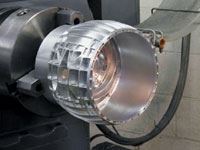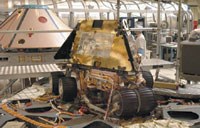Re-Inventing The Wheel
For a small machine shop in California, the night sky looks especially bright these days. The launch of Spirit and Opportunity, two identical Mars exploration rovers from NASA's Jet Propulsion Laboratory, represents not only a scientific breakthrough, but also a source of pride for the employees of Next Intent and NASA's Jet Propulsion Laboratory (JPL).
For a small machine shop in California, the night sky looks especially bright these days. The launch of Spirit and Opportunity, two identical Mars exploration rovers from NASA’s Jet Propulsion Laboratory, represents not only a scientific breakthrough, but also a source of pride for the employees of Next Intent (San Luis Obispo, California) and NASA’s Jet Propulsion Laboratory (JPL) (Pasadena, California).
The rovers were launched from Cape Canaveral, Florida, on June 10 and July 8, 2003, but the collaboration between the two companies, which made exploring the red planet possible, began several years earlier.
Rodney Babcock, president of Next Intent, recalls the excitement of knowing that the wheels, suspension arms and other components produced for the rovers were actually going to Mars. Most of the components were produced in-house at JPL, but certain parts, such as the wheels, exceeded the lab’s production capacity and were outsourced to local companies such as Next Intent.
Scientists thought that, by sending the rovers to Mars independently, the operation would succeed, despite the 303 million mile journey. With Spirit’s successful landing in the Gusev Crater on January 3, 2004, followed by Opportunity’s touchdown in the Meridiani Planum region 3 weeks later, NASA’s optimism proved to be justified.
The twin robots were designed primarily to capture detailed pictures and find evidence of water on the planet. Unlike findings from earlier missions, which offered few clues as to the extent of Mars’ watery past, the information gathered by the rovers supports the theory that the planet may have once harbored substantial bodies of standing water.
Well past their expected 3-month lifespan, the rovers continue to record sharp images, explore distances and examine a variety of rocks. The scientific returns are evident, but from JPL’s standpoint, the fact that Spirit and Opportunity survived their violent, bouncing landings is noteworthy. The wheels manufactured are said to have played an important role in the mission’s success.
The rovers can potentially collide with Mars’ surface at speeds as high as 50 mph. The wheels, therefore, had to be manufactured to be as lightweight as possible, yet durable enough to withstand a rough landing.
“JPL responded to this challenge by designing a flat section on the inside of the wheel with a large fillet radius to blend into the concave inside profile,” explains Mr. Babcock. The wheels had to be able to absorb the landing impact of 30 to 50 G. Each rover was attached to the lander with a cable pulling 2,500 pounds of down force, holding the rover tightly to the lander. When machining each wheel, the wall thickness had to be controlled to a couple thousandths of an inch.
To generate the tool paths for machining the wheels, Next Intent used GibbsCAM SolidSurfacer software from Gibbs and Associate (Moorpark, California). The raw material was 11-inch barstock of 7075 aluminum, with each piece weighing more than 54 pounds. After eight operations and 25 hours of machining, each finished wheel weighed 2.25 pounds.
Having sustained two roughing operations on a lathe, each wheel was dispatched to be heat treated and stress relieved. Following the heat treat, the wheel was returned to the lathe for two additional finishing operations. Then the VF-5 from Haas Automation (Oxnard, California) roughed and finished the inside profile.
The company created tools to machine the inside of the wheel to requisite tolerances. Customized, keyway-style tools were designed to mill the inside of the wheel. “One such tool we built for single-point finishing the interior looks like a lollipop with a round carbide insert,” says Mr. Babcock. By using this tool, a smooth surface finish was achieved and the inside tolerances were modified to 0.001". “Another operation required us to tilt the rotary table at 15 degrees to get the tool down inside the wheel,” Mr. Babcock adds.
The machining center produced the spirals on the hub of the wheel. The lathe was used to form the convex OD profile, while the VF-5 completed the outside profiling to create the tread pattern.
Read Next
The Cut Scene: The Finer Details of Large-Format Machining
Small details and features can have an outsized impact on large parts, such as Barbco’s collapsible utility drill head.
Read More3 Mistakes That Cause CNC Programs to Fail
Despite enhancements to manufacturing technology, there are still issues today that can cause programs to fail. These failures can cause lost time, scrapped parts, damaged machines and even injured operators.
Read More










.png;maxWidth=300;quality=90)












